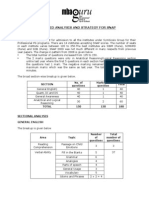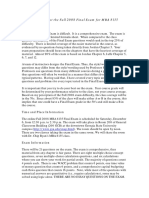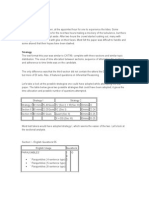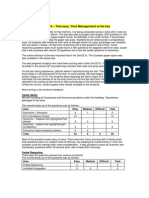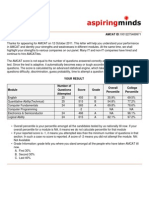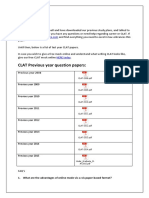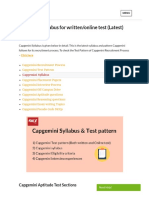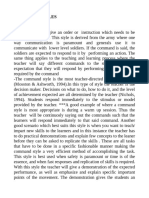SNAP-2009 Analysis by Time
SNAP-2009 Analysis by Time
Uploaded by
Sushant BhartiCopyright:
Available Formats
SNAP-2009 Analysis by Time
SNAP-2009 Analysis by Time
Uploaded by
Sushant BhartiOriginal Title
Copyright
Available Formats
Share this document
Did you find this document useful?
Is this content inappropriate?
Copyright:
Available Formats
SNAP-2009 Analysis by Time
SNAP-2009 Analysis by Time
Uploaded by
Sushant BhartiCopyright:
Available Formats
SNAP2009 Analysis by Time
Exam Snapshot
Number of Questions Sections Marking Scheme Negative Marking Number of Choices Duration 150 4 1 & 2 Marks 1/4th of the mark allotted 4 120 Min
Symbiosis National Aptitude Test is by far one of the most predictable of the management exams in India. SNAP2009 did not do anything to change this image except for the small fact that the number of Qs went up from 135 to 150. Last year SNAP had 2 mark Qs in each of the 4 sections; however that was discontinued this year. The Analytical & Logical Reasoning section of SNAP2009 was the only one that had 2 mark Qs in it. General English, QA/DI/DS and General Awareness sections had 40 Qs each while the Analytical & Logical Reasoning section had 30Qs. However the Reasoning section had the maximum weightage and students should have done well to give this section the maximum amount of time as compared to the other sections. All in all this SNAP was definitely easier than the SNAP exams of previous years and the cut-offs should scale new highs. Let us now look at the individual sections in detail:
Analytical & Logical Reasoning
The Analytical & Logical Reasoning section of SNAP2009 had the least number of questions but the maximum weightage in terms of marks. In the past this section was quite difficult but SNAP2009 reversed this trend by giving a much easier section that would not have troubled the well prepared students at all. A good strategy for any student would have been to spend a higher proportion of time in this section on account of the higher marks per question which implies a higher return for time spent. Common sense would suggest that working out the set based qs would be much more rewarding than picking up the individual Qs. However this section had very few sets and most of those sets looked more like pure observation based DI sets than analytical reasoning puzzles. The set on 'Annual Production of elements' was as easy as it can get and should have been solved in less than a minute! The puzzle on 'Boats' was easy and should have been worked out through the data given in the Qs. The table based data set on 'Airtel One' was
tricky and involved lengthy calculations and one could have made errors here if not careful. The set on the 'Production and Demand Statsistics of TV companies' was an absolute sitter and could be solved by simple observation. The individual Qs came from an assortment of topics like Strengthen & Weaken Arguments, Conclusions, Analogies, Coding Decoding, Number Logic, Non-Verbal Reasoning (Visual Reasoning) and Letter Series and were of the 'Easy-Moderate' level and students could have cracked most of them without any problem provided they had enough time to spare.
A good time allocation strategy for this section would be around 35-40 minutes. Attempts in the range of 22-24 should be considered to be very good.
General Awareness
This was probably the 'testing' section of SNAP2009 as the Qs required recall and an eye for detail. A cursory glance at the section may deceive us into believing the section was easy but after having gone through each question in a fair bit of detail, this view is bound to change. There was a preponderance of questions on Definitions (Dendrochronology, Ekistics etc.), Economy, Acronyms, History, Sport, Science & Technology and Current Affairs. This was a paper that would have played into the hands of those who have been reading a newspaper on a daily basis (yes that oft repeated advice given by us to students in every chat!) and those who have an active interest in quizzing. Given the nature of the questions wild guessing in this paper would prove to be counter productive.
A good time allocation strategy for this section would be around 15 minutes. Attempts in the range of 26-28 should be considered to be very good.
Quantitative and Data Interpretation & Sufficiency
Though this section is termed the Quantitative, DI and DS there were very few Qs from Data Interpretation area and none from the Data Sufficiency area! This section was dominated by Qs from Arithmetic, Number puzzles and some from Visual reasoning (this was a surprise). There were just two sets from Data Interpretation, both of which were pretty starightworward and should have been attempted. This section was on par with the difficulty leve of previous SNAP papers and a student who had done sufficient practice for CAT and other management tests would have been able to attempt quite a few questions in this section. The set on the 'card game' was tricky and would have troubled students however the set on Venn diagrams couldnt have been easier. A few Qs had some typos and were unresolvable and students should have recognised them as such and moved on without getting stuck on them and wasting valuable time.
A good time allocation strategy for this section would be around 30-35 minutes. Attempts in the range of 22-24 should be considered to be very good.
General English
The section had 40 questions that tested the candidates' abilities, in the areas of Comprehension (though there was just one passage), Vocabulary (meanings, usage idiomatic use, spellings and Grammar and Composition (Recognition of function, error identification, sentence correction, arrangement of jumbled sentences). SNAP2009 was a Verbal focussed paper with very little emphasis on Reading Comprehension. This was seen in the solitary RC passage that was asked and the preponderance of Qs from Vocabulary and usage. The grammar questions would have taken some time to answer because the errors were minor and difficult to spot. However those who have prepared for CAT would have found this section to be a cinch and would have scored heavily. A good time allocation strategy for this section would be around 30-35 minutes. Attempts in the range of 28-30 should be considered to be very good.
Sectional Scores and Overall Cut-Off
The participating institutes under SNAP decide on the sectional and overall cut-offs that they would be using on their own. Students should remember that just because an institute has NOT explicitly disclosed the sectional and overall cutoffs doesnt mean that they do not have such cut-offs. We have therefore always advised our students to ensure that they do well in all sections of SNAP. Studenst should also keep in mind that the procedure followed by any of the Symbiosis institutes last year would have little bearing on what they would do this year and hence one can and should expect surprises from each one of them in their GDPI Call criteria. The cut-offs which we have given below are under the assumption that the Symbiosis institites would stick to what they had done last year in terms of the sectional and overall cut-offs.
One should note that many of the participating institutes using SNAP scores in 2008 had sectional and overall cut-offs. It would not be a surprise to see most of them using the sectional filter this year as the number of test takers is quite high. A safe score to get calls from the top institute (SIBM Pune) would be around 98+ with good scores in all four sections.
Cut-off Estimates for SNAP2009
Institute
Quantitative and Data Analytical & Interpretation & General Logical Awareness Sufficiency Reasoning
General English
Estimated Cut-Off
Comment
SIBM (Pune) SCM-HRD SIIB SITM SCIT SIOM SIMS SICSR SIMC SIG SIHS
32-34 24-26 20-22 18-20 16+ 12+
8-10 6-8 6+ 6+ 6+ 6+
18-20 12-14 8-10 8-10 7+ 5+
20-22 18-20 12-14 12-14 10-12 8-10
98-102 86-90 82-86 80-82 76+ 62+ 62+ 50+
12+
5+
4+
8-10
Will be around 4-6 marks less for Bangalore campus Based on Profile. Work-Ex and Acads given weightage Based on Profile*** *** *** *** *** *** *** *** ***
***Estimated sectional cut-off in case the institute goes for sectional cut-offs
You might also like
- Access Bank Study Pack-1-Unlocked PDFDocument318 pagesAccess Bank Study Pack-1-Unlocked PDFOmole E David100% (1)
- Digital SAT Preview: What to Expect + Tips and StrategiesFrom EverandDigital SAT Preview: What to Expect + Tips and StrategiesRating: 5 out of 5 stars5/5 (4)
- IELTS Academic Writing: How To Write 8+ Answers For The IELTS Exam!From EverandIELTS Academic Writing: How To Write 8+ Answers For The IELTS Exam!Rating: 4.5 out of 5 stars4.5/5 (7)
- LSAT PrepTest 75 Unlocked: Exclusive Data, Analysis & Explanations for the June 2015 LSATFrom EverandLSAT PrepTest 75 Unlocked: Exclusive Data, Analysis & Explanations for the June 2015 LSATNo ratings yet
- Detailed Analysis and Strategy For SnapDocument5 pagesDetailed Analysis and Strategy For SnapMichael GeorgeNo ratings yet
- JMET 2009 Exam SnapshotDocument3 pagesJMET 2009 Exam SnapshotvishalnaibNo ratings yet
- Csat Jan 2011Document39 pagesCsat Jan 2011Dr. Vinod GuptaNo ratings yet
- Cat'12 Exam Analysis: Home Exam Analysis GP Ka Funda Watch Cat Fundas E-Resources B-School NotificationsDocument3 pagesCat'12 Exam Analysis: Home Exam Analysis GP Ka Funda Watch Cat Fundas E-Resources B-School NotificationsSagar ShahNo ratings yet
- Simcat 4 Experts ' TakeDocument6 pagesSimcat 4 Experts ' TakeKetan MNo ratings yet
- SNAP 2012 Analysis: 1. Logical Reasoning - 30 QuestionsDocument3 pagesSNAP 2012 Analysis: 1. Logical Reasoning - 30 QuestionsAchyutPareekNo ratings yet
- How To Prepare For DILRDocument19 pagesHow To Prepare For DILRmovie downloadNo ratings yet
- SSC CGL 90 Days Strategy and Study Plan Final 1530084108 54 PDFDocument10 pagesSSC CGL 90 Days Strategy and Study Plan Final 1530084108 54 PDFDharshit D rajNo ratings yet
- Important Information For Cat 2014Document7 pagesImportant Information For Cat 2014Amit MishraNo ratings yet
- Syllabus For LIC AAODocument18 pagesSyllabus For LIC AAOmahesh_rai44No ratings yet
- Common Admissions Test (CAT) PatternDocument2 pagesCommon Admissions Test (CAT) PatternnikswamiNo ratings yet
- Analysis: SNAP 2012: Overview of Different SectionsDocument2 pagesAnalysis: SNAP 2012: Overview of Different SectionsKaranwadhwaNo ratings yet
- CAT '09: Tips For The Quantitative Ability SectionDocument15 pagesCAT '09: Tips For The Quantitative Ability SectionAniket DaooNo ratings yet
- FSC 22-23 Student Workload Survey ReportDocument23 pagesFSC 22-23 Student Workload Survey Reportaljhonrase2008No ratings yet
- Information About The Summer 2010 Final Exam For MBA 8135Document4 pagesInformation About The Summer 2010 Final Exam For MBA 8135yazanNo ratings yet
- MBA CET PreparationDocument5 pagesMBA CET PreparationRavindra SharmaNo ratings yet
- Arun Sharma Articles-1Document27 pagesArun Sharma Articles-1Meghdoot MukherjeeNo ratings yet
- Prepare NetDocument8 pagesPrepare Netabhi67% (3)
- Arun Sharma ArticlesDocument28 pagesArun Sharma ArticlesSubodh SaurabhNo ratings yet
- CAT Duration and Pattern: Data Interpretation The Second Section Is Verbal Ability & Logical Reasoning. TheseDocument13 pagesCAT Duration and Pattern: Data Interpretation The Second Section Is Verbal Ability & Logical Reasoning. TheseiknowkedarNo ratings yet
- CMAT StructureDocument2 pagesCMAT StructureDwijendra B. SrivastavaNo ratings yet
- Aircat 1201Document21 pagesAircat 1201vibhorchaudharyNo ratings yet
- Information About The Spring 2009 Final Exam For MBA 8135Document4 pagesInformation About The Spring 2009 Final Exam For MBA 8135yazanNo ratings yet
- How To Prepare For Quantitative AptitudeDocument5 pagesHow To Prepare For Quantitative AptitudeGaurav JayantNo ratings yet
- Information About The Fall 2008 Final Exam For MBA 8135Document4 pagesInformation About The Fall 2008 Final Exam For MBA 8135yazanNo ratings yet
- CAT 2000: Analysis: StrategyDocument5 pagesCAT 2000: Analysis: Strategymvenkat3272No ratings yet
- Feedback On CET 2014 - First Day First Slot AnalysisDocument3 pagesFeedback On CET 2014 - First Day First Slot AnalysisSameer PandeyNo ratings yet
- CFA TipsDocument4 pagesCFA Tipsfdomingojr_doe100% (1)
- How To Prepare Quantitative Aptitude For SBI PODocument27 pagesHow To Prepare Quantitative Aptitude For SBI POSushilGirdherNo ratings yet
- Enterance Exams KnowledgeDocument7 pagesEnterance Exams Knowledgedeepak18mNo ratings yet
- EFIM10005 Exam Report Jan 22 Final(1)Document7 pagesEFIM10005 Exam Report Jan 22 Final(1)liulilianxinhuoNo ratings yet
- NMAT 2010 AnalysisDocument2 pagesNMAT 2010 AnalysisKarishma GuptaNo ratings yet
- AP Stats Chapter 7 Homework AnswersDocument4 pagesAP Stats Chapter 7 Homework Answersafnoawnnaeykxk100% (1)
- Your Result Number of Questions Attempted Score Grade Overall Percentile College PercentileDocument7 pagesYour Result Number of Questions Attempted Score Grade Overall Percentile College PercentileYellaReddy TarigopulaNo ratings yet
- SBI PO Pattern: Kya Aayega", "Prelims Ke Liye Kitna Padhna Padega"Document6 pagesSBI PO Pattern: Kya Aayega", "Prelims Ke Liye Kitna Padhna Padega"adarshNo ratings yet
- MS Rbi IDocument6 pagesMS Rbi IsrNo ratings yet
- Detailed View of SBI PO 2015 - Expected PatternDocument4 pagesDetailed View of SBI PO 2015 - Expected PatternPoulami Saanjhbati DasguptaNo ratings yet
- BSNL Jto Exam 09Document2 pagesBSNL Jto Exam 09jto 09No ratings yet
- CLAT Previous Year PapersDocument3 pagesCLAT Previous Year PapersNishika FagnaNo ratings yet
- How To Pass E1, Enterprise Operations?: Whatdoineedtodotopasse1?Document5 pagesHow To Pass E1, Enterprise Operations?: Whatdoineedtodotopasse1?Sampth KarunarathneNo ratings yet
- Capgemini SyllabusDocument8 pagesCapgemini SyllabusVishal GuptaNo ratings yet
- Detailed Syllabus For IBPS PO Prelims 2018 Based On New Pattern Check NowDocument12 pagesDetailed Syllabus For IBPS PO Prelims 2018 Based On New Pattern Check NowEyaminNo ratings yet
- Arun Sharma ArticlesDocument40 pagesArun Sharma Articlesnaveen1830% (1)
- Why UPCAT Reviewer Is Better Than Traditional Review CentersDocument11 pagesWhy UPCAT Reviewer Is Better Than Traditional Review CentersElizabeth LeeNo ratings yet
- GATE Topper Interview - 85+marks Study Plan in GATE - Mechanical - GATE-IES-PSU 2018 - Topper Notes and GuidanceDocument4 pagesGATE Topper Interview - 85+marks Study Plan in GATE - Mechanical - GATE-IES-PSU 2018 - Topper Notes and GuidanceADITYA0% (1)
- SSCCGL Maths Quantitative Aptitude Algebra Trigonometry Approach Booklist Strategy Free StuDocument10 pagesSSCCGL Maths Quantitative Aptitude Algebra Trigonometry Approach Booklist Strategy Free StuVishnu VardhanNo ratings yet
- Score Higher On The Ukcat, 5Th Edition - 2019 UpdateDocument2 pagesScore Higher On The Ukcat, 5Th Edition - 2019 UpdateNikki Fish0% (1)
- Ielts Writing Success. The Essential Step by Step Guide for Task 1 Writing. 8 Practice Tests for Bar Charts & Line Graphs. w/Band 9 Model Answer Key & On-line Support.From EverandIelts Writing Success. The Essential Step by Step Guide for Task 1 Writing. 8 Practice Tests for Bar Charts & Line Graphs. w/Band 9 Model Answer Key & On-line Support.Rating: 5 out of 5 stars5/5 (1)
- Digital SAT Reading and Writing Practice Questions: Test Prep SeriesFrom EverandDigital SAT Reading and Writing Practice Questions: Test Prep SeriesRating: 5 out of 5 stars5/5 (2)
- IELTS Academic Writing - Discover The Secrets To Writing 8+ Answers For The IELTS Exams! (High Scoring Sample Answers Included)From EverandIELTS Academic Writing - Discover The Secrets To Writing 8+ Answers For The IELTS Exams! (High Scoring Sample Answers Included)No ratings yet
- Pottery Lesson PlanDocument5 pagesPottery Lesson Planapi-264582141No ratings yet
- ENG3U SpeechDocument5 pagesENG3U SpeechSteve M HallNo ratings yet
- Schools of Psychology - SlidesDocument33 pagesSchools of Psychology - SlidesSheenah SiapnoNo ratings yet
- Lesson 4 ReviewDocument2 pagesLesson 4 Reviewapi-177710763No ratings yet
- Class Poster On Zeno of EleaDocument1 pageClass Poster On Zeno of EleaFrank HurdleNo ratings yet
- Siemens, G. 2004. A Learning Theory For The Digital AgeDocument6 pagesSiemens, G. 2004. A Learning Theory For The Digital AgeJennifer PantoniNo ratings yet
- Lesson Plan For Twist Dance and Mashed PotsDocument2 pagesLesson Plan For Twist Dance and Mashed Potsapi-317476163No ratings yet
- FCE 3204 The Brain of HumanDocument7 pagesFCE 3204 The Brain of HumanbushairyNo ratings yet
- The Ontology of Art in Philosophy of Nicolai HartmannDocument8 pagesThe Ontology of Art in Philosophy of Nicolai HartmannNordsci Conference100% (1)
- The Scope of Psycho Linguistics and The Significant of Psycho Linguistics For Language Teaching and LearningDocument2 pagesThe Scope of Psycho Linguistics and The Significant of Psycho Linguistics For Language Teaching and LearningFadel Tjipta89% (46)
- Does A Chimpanzee Have A Theory of MindDocument12 pagesDoes A Chimpanzee Have A Theory of Mindkyuzo1313No ratings yet
- Issues That Are Challenging To Teachers Integration of Information and Communication Technology (Ict) in Teaching and LearningDocument5 pagesIssues That Are Challenging To Teachers Integration of Information and Communication Technology (Ict) in Teaching and LearningAnis AtiqahNo ratings yet
- L'Express - Interview With Jacques LacanDocument12 pagesL'Express - Interview With Jacques LacanBananna LaFleur100% (1)
- Accounting Research Methods-NotesDocument5 pagesAccounting Research Methods-NotesShiela De JesusNo ratings yet
- Assessment Bsbled401 (Amy)Document16 pagesAssessment Bsbled401 (Amy)Shar KhanNo ratings yet
- HJORLAND, 2015. Are Relations in ThesauriDocument7 pagesHJORLAND, 2015. Are Relations in ThesauriKamila MouraNo ratings yet
- JBI Critical Appraisal-Checklist For Quasi - Experimental StudiesDocument6 pagesJBI Critical Appraisal-Checklist For Quasi - Experimental StudiesHendra Kurnia RakhmaNo ratings yet
- From Goldfish To ElephantDocument5 pagesFrom Goldfish To ElephantparaggadhiaNo ratings yet
- Descriptive Ethics: By:maryon Dhel GarciaDocument13 pagesDescriptive Ethics: By:maryon Dhel GarciamharyohnNo ratings yet
- Semantic Perception Theory - A New Theory On Children's Language DevelopmentDocument241 pagesSemantic Perception Theory - A New Theory On Children's Language DevelopmentPaulo Ney LeiteNo ratings yet
- Monitoring Learner ProgressDocument23 pagesMonitoring Learner ProgressEmilia Gomes Barbosa BarbosaNo ratings yet
- Practical Research I: Qualitative Research Reviewer: Free Online Database SamplesDocument3 pagesPractical Research I: Qualitative Research Reviewer: Free Online Database SamplesElenear De OcampoNo ratings yet
- Foundations of Organizational ExcellenceDocument18 pagesFoundations of Organizational ExcellenceShailendra KelaniNo ratings yet
- Teacher Centred Teaching StylesDocument9 pagesTeacher Centred Teaching StylesNolwazi NkomoNo ratings yet
- Elum Valley Public High School Islampur Swat Chapter #: 2 Biology For Class 9Document4 pagesElum Valley Public High School Islampur Swat Chapter #: 2 Biology For Class 9Safdar AliNo ratings yet
- Biases and PropagandaDocument20 pagesBiases and PropagandaRaymond LumbaoNo ratings yet
- Planning and Managing Interpretive SignageDocument74 pagesPlanning and Managing Interpretive SignageAhmed RjoobNo ratings yet
- Answer Key Q1Document21 pagesAnswer Key Q1Bernie P. RamaylaNo ratings yet
- Kwan Annals 2002Document18 pagesKwan Annals 2002Sofia ChacaltanaNo ratings yet
- "Educational Research Nature": Laura Estrada Gómez-Acebo 2° Pre-Primary Education Universidad Rey Juan Carlos, VicálvaroDocument4 pages"Educational Research Nature": Laura Estrada Gómez-Acebo 2° Pre-Primary Education Universidad Rey Juan Carlos, VicálvaroLaura Estrada Gómez-AceboNo ratings yet




